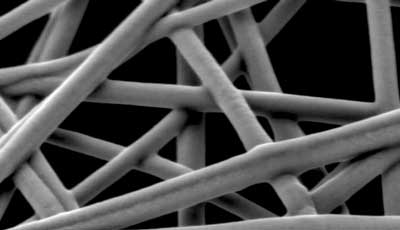| Dec 10, 2018 | |
Sensitive e-skin embedded with nanowires(Nanowerk News) An artificial soft skin imbued with flexible electronics could enhance the way robots sense and interact with their surroundings, KAUST researchers have shown (Advanced Electronic Materials,"Toward programmable materials for wearable electronics: Electrical welding turns sensors into conductors"). The team has discovered how to program electrical conductivity and strain sensing into a single material embedded in a stretchy polymer skin. The discovery could also have applications in wearable electronic devices. |
|
 |
|
| Electrical welding forms strong welded joints between the mesh of nanowires. (© Wiley-VCH) | |
| When an animal stretches a limb, a network of nerves and sensors within the skin provides feedback that help it orient the limb in space and interact with its surroundings. Embedding a network of strain sensors and connective wiring into a flexible artificial skin would give soft robots similar sensory feedback, helping them autonomously navigate their environment, says Gilles Lubineau, who led the research. | |
| Until now, researchers have used different materials for the sensing and conductive wiring components, adding cost and complexity to the fabrication process, explains Ragesh Chellattoan, a Ph.D. student in Lubineau’s team. “Our objective is to get both sensing and wiring connectivity in the one material,” he says. | |
| The team developed an artificial material comprising a flexible polymer embedded with silver nanowires. Individually, each nanowire is conductive, but high resistance at the junctions between the them limits overall conductivity through the material. The resistance increases markedly when the material is flexed and the nanowires are pulled apart such that the nanowire network acts like a strain sensor. | |
| But that behavior can be altered, the team showed. Applying a DC voltage made the nanowire network very hot at the points of high resistance, where the nanowires meet. This localized heating acts to weld neighboring nanowires together, forming a highly conductive firmly bonded network that is impervious to stretching and flexing. | |
 |
|
| The leg of the action figure was coated in a strain-sensing artificial skin to demonstrate the material in action. (© Wiley-VCH) | |
| “Electrical welding joins thousands of junctions in the network within 30 seconds,” Chellattoan says. Changing how the current is introduced controls which parts become conductive. |
| Source: King Abdullah University of Science and Technology | |
|
Subscribe to a free copy of one of our daily Nanowerk Newsletter Email Digests with a compilation of all of the day's news. |
